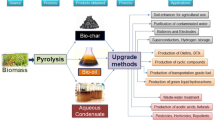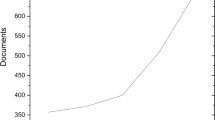Abstract
Recently, substitution of primary resources by renewable alternatives is strongly concerned. With this stream, new environmental-friendly polyester is prepared using natural oleic acid and biomass resources, for the first time. A biomass (BM) waste mixture was subjected to liquification reaction with polyol, then the liquefied biomass (LBM) was reacted with natural oleic acid to get LBM-based polyester (PES-LBM). The exothermic properties showed longer period of curing that allows easier processing. PES-LBM has minimum emitted temperature during crosslinking, compared with other commercial types. FTIR emphasized liquification of biomass, and its reaction with oleic to form PES-LBM. XRD showed change in structure after reacting crystalline LBM with oleic acid getting polyester phase. The obtained PES-LBM polymer has improved thermal properties, due to thermal decomposition at higher temperatures with lower weight loss. DSC shows transitions of polyester segments. Furthermore, the hardness of PES-LBM is enhanced by 6.4% compared with the reference polymer taken. The characterization sentence approved the successful preparation of novel polyester with improved properties, as long as the environmental impact.





Similar content being viewed by others
References
Bassi S, Boldrin A, Frenna G, Astrup TF (2021) An environmental and economic assessment of bioplastic from urban biowaste. The example of polyhydroxyalkanoate. Bioresour Technol 327:124813
Asim N, Badiei M, Torkashvand M, Mohammad M, Alghoul MA, Gasaymeh SS, Sopian K (2021) Wastes from the petroleum industries as sustainable resource materials in construction sectors: opportunities, limitations, and directions. J Clean Prod 284:125459
Atiwesh G, Mikhael A, Parrish CC, Banoub J, Le T-AT (2021) Environmental impact of bioplastic use: a review. Heliyon 7:e07918
Evode N, Qamar SA, Bilal M, Barceló D, Iqbal HM (2021) Plastic waste and its management strategies for environmental sustainability. Case Stud Chem Environ Eng 4:100142
Makkam S, Harnnarongchai W (2014) Rheological and mechanical properties of recycled PET modified by reactive extrusion. Energy Procedia 56:547–553
Sinha V, Patel MR, Patel JV (2010) PET waste management by chemical recycling: a review. J Polym Environ 18:8–25
Hou G, Yan Z, Sun J, Naguib HM, Lu B, Zhang Z (2021) Microstructure and mechanical properties of CO2-cured steel slag brick in pilot-scale. Constr Build Mater 271:121581
Hou G, Naguib HM, Chen S, Yao H, Lu B, Chen J (2019) Mechanisms and optimal reaction parameters of accelerated carbonization of calcium silicate. Kuei Suan Jen Hsueh Pao/J Chin Ceram Soc 47:1175–1180
Hou G, Chen J, Lu B, Chen S, Cui E, Naguib HM, Guo M-Z, Zhang Q (2020) Composition design and pilot study of an advanced energy-saving and low-carbon rankinite clinker. Cem Concr Res 127:105926
Potluri R, Krishna NC (2020) Potential and applications of green composites in industrial space. Mater Today: Proc 22:2041–2048
Murali B, Yogesh P, Karthickeyan NK, Chandramohan D (2022) Multi-potency of bast fibers (flax, hemp and jute) as composite materials and their mechanical properties: a review. Mater Today: Proc 62:1839–1843
Goodman BA (2020) Utilization of waste straw and husks from rice production: a review. J Bioresour Bioprod 5:143–162
Shi Y, Li J, Wang J, Zhao T, Yang H, Jiang J, Jiang X (2016) Kinetic and product composition study on the cellulose liquefaction in polyhydric alcohols. Bioresour Technol 214:419–425
Guo K, Guan Q, Xu J, Tan W (2019) Mechanism of preparation of patform compounds from lignocellulosic biomass liquefaction catalyzed by bronsted acid: a review. J Bioresour Bioprod 4:202–213
Zhang H, Yang H, Guo H, Huang C, **ong L, Chen X (2014) Kinetic study on the liquefaction of wood and its three cell wall component in polyhydric alcohols. Appl Energy 113:1596–1600
Rhazi N, Hannache H, Oumam M, Sesbou A, Charrier B, Pizzi A, Charrier-El Bouhtoury F (2019) Green extraction process of tannins obtained from Moroccan Acacia mollissima barks by microwave: modeling and optimization of the process using the response surface methodology RSM. Arab J Chem 12:2668–2684
Huang H-J, Yuan X-Z (2015) Recent progress in the direct liquefaction of typical biomass. Prog Energy Combust Sci 49:59–80
Jiang W, Kumar A, Adamopoulos S (2018) Liquefaction of lignocellulosic materials and its applications in wood adhesives—a review. Ind Crops Prod 124:325–342
Naguib HM, Kandil UF, Hashem AI, Boghdadi YM (2015) Effect of fiber loading on the mechanical and physical properties of “green” bagasse–polyester composite. J Radiat Res Appl Sci 8:544–548
Naguib HM (2018) Environmental-friendly recycled Polyester/Mg(OH)2 nanocomposite: Fire-retardancy and thermal stability. Polym Test 72:308–314
Vale M, Mateus MM, dos Santos RG, de Castro CN, de Schrijver A, Bordado JC, Marques AC (2019) Replacement of petroleum-derived diols by sustainable biopolyols in one component polyurethane foams. J Clean Prod 212:1036–1043
Chen F, Lu Z (2009) Liquefaction of wheat straw and preparation of rigid polyurethane foam from the liquefaction products. J Appl Polym Sci 111:508–516
Juhaida MF, Paridah MT, Hilmi MM, Sarani Z, Jalaluddin H, Zaki AR (2010) Liquefaction of kenaf (Hibiscus cannabinus L.) core for wood laminating adhesive. Bioresour Technol 101:1355–1360
Satyarthi JK, Chiranjeevi T, Gokak DT, Viswanathan PS (2013) An overview of catalytic conversion of vegetable oils/fats into middle distillates. Catal Sci Technol 3:70–80
Kerenkan AE, Béland F, Do TO (2016) Chemically catalyzed oxidative cleavage of unsaturated fatty acids and their derivatives into valuable products for industrial applications: a review and perspective. Catal Sci Technol 6:971–987
Deka B, Sharma R, Mandal A, Mahto V (2018) Synthesis and evaluation of oleic acid based polymeric additive as pour point depressant to improve flow properties of Indian waxy crude oil. J Pet Sci Eng 170:105–111
Patel MR, Chitte PS, Bharambe DP (2017) Oleic acid based polymeric flow improvers for Langhnaj (North Gujarat, India) crude oil. Egypt J Pet 26:895–903
Pouya ZA, Tofighy MA, Mohammadi T (2021) Synthesis and characterization of polytetrafluoroethylene/oleic acid-functionalized carbon nanotubes composite membrane for water desalination by vacuum membrane distillation. Desalination 503:114931
Gan H, Hutchinson SA, Hurren C, Liu Q, Wang X, Long RL (2021) Effect of oleic purity on the chemical structure, thermal and rheological properties of bio-based polymers derived from high oleic cottonseed oil via RAFT polymerization. Ind Crops Prod 171:113882
Aritonang B, Tamrin, Wirjosentono B, Eddiyanto (2020) Effect of graft copolymerization of oleic acid on to cyclic natural rubber in polyamide. Case Stud Therm Eng 21:100690
Yahya MZ, Arof AK (2003) Effect of oleic acid plasticizer on chitosan–lithium acetate solid polymer electrolytes. Eur Polym J 39:897–902
Smith AD, Smith RC, Tennyson AG (2020) Polymer cements by copolymerization of waste sulfur, oleic acid, and pozzolan cements. Sustain Chem Pharm 16:100249
Briones R, Serrano L, Labidi J (2012) Valorization of some lignocellulosic agro-industrial residues to obtain biopolyols. J Chem Technol Biotechnol 87:244–249
Hu S, Wan C, Li Y (2012) Production and characterization of biopolyols and polyurethane foams from crude glycerol based liquefaction of soybean straw. Bioresour Technol 103:227–233
Junming X, Jianchun J, **g L (2012) Preparation of polyester polyols from unsaturated fatty acid. J Appl Polym Sci 126:1377–1384
Cabrales L, Calderon K, Hinojosa I, Valencia F, Abidi N (2016) Synthesis and characterization of polyesters derived from sebacic acid, hexanediol, and hydroquinone. Int J Polym Anal Charact 21:718–727
Beheshty MH, Nasiri H, Vafayan M (2005) Gel time and exotherm behaviour studies of an unsaturated polyester resin initiated and promoted with dual systems. Iran Polym J 140:990–999
Shimkin AA (2016) Methods for the determination of the gel time of polymer resins and prepregs. Russ J Gen Chem 86:1488–1493
Mangeon C, Renard E, Thevenieau F, Langlois V (2017) Networks based on biodegradable polyesters: an overview of the chemical ways of crosslinking. Mater Sci Eng C 80:760–770
Atta AM, Elnagdy SI, Abdel-Raouf ME, Elsaeed SM, Abdel-Azim AA (2005) Compressive properties and curing behaviour of unsaturated polyester resins in the presence of vinyl ester resins derived from recycled poly (ethylene terephthalate). J Polym Res 12:373–383
Chen J-W, Chen L-W (1999) The glycolysis of poly (ethylene terephthalate). J Appl Polym Sci 73:35–40
Ferrer A, Alciaturi C, Faneite A, Rios J (2016) Analyses of biomass fibers by XRD, FT-IR, and NIR. In: Vaz JrS (ed) Analytical techniques and methods for biomass. Springer, Cham
Bal S, Behera RC (2006) Structural investigation of chemical treated polyester fibers using saxs and other techniques. J Min Mater Charact Eng 5:179–198
Naguib HM, Zhang XH (2018) Advanced recycled polyester based on PET and oleic acid. Polym Test 69:450–455
Naguib HM, Ahmed MA, Abo-Shanab ZL (2018) Silane coupling agent for enhanced epoxy-iron oxide nanocomposite. J Mater Res Technol 7:21–28
Naguib HM, Ahmed MA, Abo-Shanab ZL (2019) Studying the loading impact of silane grafted Fe2O3 nanoparticles on mechanical characteristics of epoxy matrix. Egypt J Pet 28:27–34
Abo-Shanab ZL, Ragab AA, Naguib HM (2021) Improved dynamic mechanical properties of sustainable bio-modified asphalt using agriculture waste. Int J Pavement Eng 22:905–911
Mohamed MR, Naguib HM, El-Ghazawy RA, Shaker NO, Amer AA, Soliman AM, Kandil UF (2019) Surface activation of wood plastic composites (WPC) for enhanced adhesion with epoxy coating. Mater Perform Charact 8:22–40
Alnajjar HM, Naguib HM, Shaker NO, Ahmed H, Farag AA, Kandil UF (2019) Enhancement of recycled WPC with epoxy nanocomposite coats. Egypt J Chem 62:555–563
Acknowledgements
This work was supported by Science, Technology & Innovation Funding Authority - Call 10 / Young Researchers Grant (STDF-YRG) / STDF − 43171 to EPRI. The acknowledge for following programs and organizations is also involved: Science and Technology Plan Project of Jiangsu Province, “the Belt and Road” innovation cooperation project (BZ2020012), the Key Lab. for Advanced Technology in Environment Protection of Jiangsu Province, Yancheng Institute of Technology, Yancheng, China.
Funding
The authors have not disclosed any funding.
Author information
Authors and Affiliations
Contributions
HMN: conceptualization, validation, writing, data curation, review & editing. GH: supervision, methodology, original draft, investigation, writing, final revision.
Corresponding author
Ethics declarations
Conflict of interest
The authors declare no competing interests.
Additional information
Publisher’s Note
Springer Nature remains neutral with regard to jurisdictional claims in published maps and institutional affiliations.
Rights and permissions
Springer Nature or its licensor (e.g. a society or other partner) holds exclusive rights to this article under a publishing agreement with the author(s) or other rightsholder(s); author self-archiving of the accepted manuscript version of this article is solely governed by the terms of such publishing agreement and applicable law.
About this article
Cite this article
Naguib, H.M., Hou, G. Exploitation of Natural and Recycled Biomass Resources to Get Eco-friendly Polymer. J Polym Environ 31, 533–540 (2023). https://doi.org/10.1007/s10924-022-02631-x
Accepted:
Published:
Issue Date:
DOI: https://doi.org/10.1007/s10924-022-02631-x




